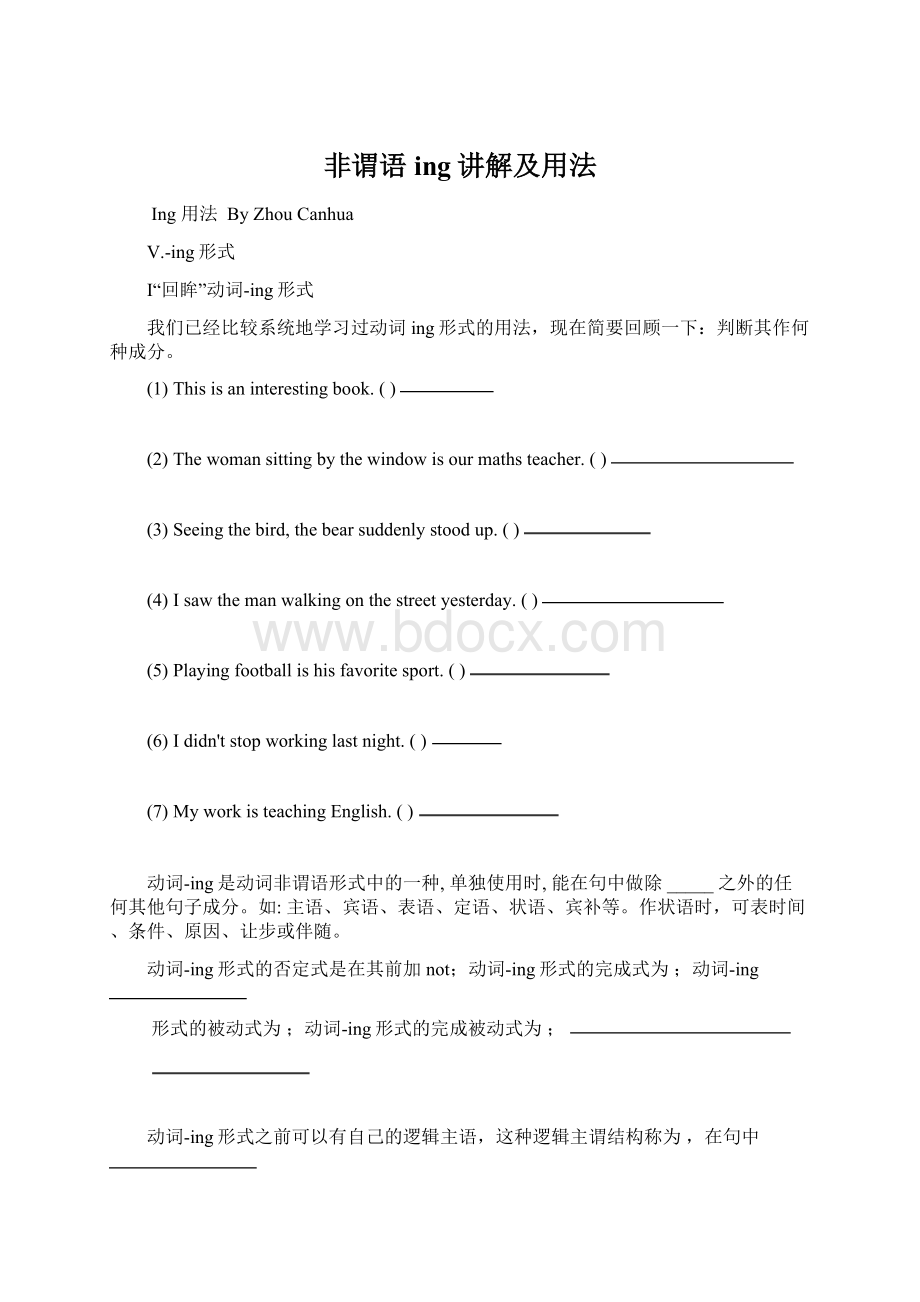非谓语 ing讲解及用法.docx
《非谓语 ing讲解及用法.docx》由会员分享,可在线阅读,更多相关《非谓语 ing讲解及用法.docx(22页珍藏版)》请在冰豆网上搜索。

非谓语ing讲解及用法
Ing用法ByZhouCanhua
V.-ing形式
Ⅰ“回眸”动词-ing形式
我们已经比较系统地学习过动词ing形式的用法,现在简要回顾一下:
判断其作何种成分。
(1)Thisisaninterestingbook.()
(2)Thewomansittingbythewindowisourmathsteacher.()
(3)Seeingthebird,thebearsuddenlystoodup.()
(4)Isawthemanwalkingonthestreetyesterday.()
(5)Playingfootballishisfavoritesport.()
(6)Ididn'tstopworkinglastnight.()
(7)MyworkisteachingEnglish.()
动词-ing是动词非谓语形式中的一种,单独使用时,能在句中做除_____之外的任何其他句子成分。
如:
主语、宾语、表语、定语、状语、宾补等。
作状语时,可表时间、条件、原因、让步或伴随。
动词-ing形式的否定式是在其前加not;动词-ing形式的完成式为;动词-ing
形式的被动式为;动词-ing形式的完成被动式为;
动词-ing形式之前可以有自己的逻辑主语,这种逻辑主谓结构称为,在句中
作状语,如本单元中出现的句子:
Theothertwoclimbeddownintothecratertocollectsomelava
forlaterstudy,butthisbeingmyfirstexperience,Istayedatthetopandwatchedthem.
Ⅱ聚焦V-ing形式作状语
V-ing形式作状语,可表示时间、原因、方式、伴随、条件等。
试判断下面句子属于何种状语:
1.Shesatatthedeskreadinganewspaper.()
2.HangWeiwenttoschool,takingatrain.()
3.Whilereadingthebook,henoddedfromtimetotime.()
4.Nothavingreceivedareply,wewroteagain.()
5.Heatingwater,wecanchangeitintovapor.()
一、现在分词短语作时间状语有以下情况:
1.分词动作一发生,谓语动作紧跟着发生,这时用现在分词的一般式作时间状语,其逻辑
主语为句中的主语。
常用hear,see,arrive,return,getto,look,open,close,leave,turnaround,walk等,表示一个极短暂动作。
此种情况可以换作on+动名词,表示相同的意思。
译作一(刚)……就……。
此种情况也可以换作是when引导的时间状语从句,该从句的动词多用一般过去时表示。
如:
Hearingtheirteacher'svoice,thepupilsstoppedtalkingatonce.(=Onhearingtheirteacher'svoice…=Whentheyheardtheirteacher'svoice,thepupils…)
一听到教师的声音,学生们立即停止讲话。
2.谓语动作发生在分词所表示的动作过程之中,则用when/while+现在分词的一般式,分
词的逻辑主语为句中的主语。
此种情况可以用in+动名词的一般式代替。
也可以换作when、while引导的时间状语从句,该从句的谓语动词用进行时态。
如:
Don'tbecarelesswhen/whilehavinganexam.=Don'tbecarelessinhavinganexam.
=Don'tbecarelesswhen/whileyouarehavinganexam.考试时不要粗心。
二表示原因,相当于一个原因状语从句。
Beingill,hedidn'tgotoschoolyesterday.由于生病,他昨天没有上学。
(=Sincehewasill...)
BecauseIdidn'tmasterthewayofstudying,Ididn'tgetagoodresult.=Notmasteringthewayof
studying,Ididn'tgetagoodresult.
AsIwassoworried,Icouldn'tgotosleep.=Beingsoworried,Icouldn'tgotosleep.
三表示结果,相当于一个结果状语。
1
Hisfatherdied,leavinghimalotofmoney.=thus,lefthimalotofmoney.
他父亲死了,留给他许多钱.
四表示条件,相当于一个条件状语从句。
Workinghardatyourlessons,youwillsucceed.=Ifyouworkhardatyourlessons…
如果你努力学习,就一定能成功。
Ifyoupassthethreeyears,you'llgrowup.=Passingthethreeyears,you'llgrowup.
Ifyoudon'tmakeuseofthetime,you'llregret.=Notmakinguseofthetime,you'llregret.
五表示让步,相当于一个让步状语从句。
Knowingallthis,theymademepayforthedamage.=Althoughtheyknewallthis...
尽管知道了一切情况,他们还是要我赔偿损失。
AlthoughIstudiedfrommorningtillnight,Ididn'tpasstheexam.
=Studyingfrommorningtillnight,Ididn'tpasstheexam.
EventhoughImadeupmymind,Istillwantedtoplay.
=Makingmadeupmymind,Istillwantedtoplay.
六表示行为方式、伴随情况或补充说明,相当于一个并列结构。
Helayonthegrass,staringattheskyforalongtime.=...andstaredattheskyforalongtime
他躺在草地上,长时间地望着天空。
一般情况下,动词-ing所表示的动作和谓语动词所表示的动作同时发生,它没有相应的状语从句可以转换,但可以用并列句转换。
Thegirlcameintotheclassroom,singinganddancing.
=Thegirlcameintotheclassroomandtheysanganddanced.
特别提醒:
为了使动词-ing形式作状语所表达的时间、条件、让步等意思更加明确,可在动词-ing形式前加上适当的连词(when,while,if,though,unless,evenif等)。
例如:
Don'ttalkwhilehavingdinner.
学习V-ing形式作状语的用法时,需要注意以下四点:
(一)与过去分词作状语的区别。
一般来说,-ing形式表示主动、进行;过去分词表示被动、完成。
试比较:
Theenemyfledinapanic,leavingbehindalotofdeadbodiesandweapons.
Defeatedandfrightened,theenemyfledinapanic.分析:
前一例中的-ing形式短语在句子中作
伴随状语,它与其逻辑主语theenemy之间为主动关系;后一句中的过去分词defeated和
frightened表原因,它与其逻辑主语theenemy之间为被动关系。
(二)关于逻辑主语的问题。
-ing形式作状语时,一般情况下,其逻辑主语应与主句的主语保持一致。
如:
Comparingallthegreatpeoplewitheachother,you'llfindthattheyhavemuchincommon.
Findinghercarstolen,shehurriedtoapolicemanforhelp.(上海2001,28)
Havingsufferedfromhearttroubleforyears,ProfessorWhitehastotakesomemedicinewithhim
whereverhegoes.(上海2001春,38)
Havingsufferedsuchheavypollutionalready,itmaynowbetoolatetocleanuptheriver.
分析:
前三例中,-ing形式的逻辑主语均为主句的主语。
最后一例中,havingsuffered的逻辑主语是theriver,并不是主句的主语it。
这种用法极为少见,有的语法家称其为垂悬分词,我们在学习中不宜模仿。
如果状语与主语不一致,可给从句加上主语,变成主从复合句。
例如:
【错误】Whilereadingthebook,thetelephonerang.
【正确】Whileshewasreadingthebook,thetelephonerang.
她看书的时候,电话铃响了。
(reading的动作不是thetelephone发出)
【错误】Lookingoutthroughthewindow,thegardenwasbeautiful.
【正确】Lookingoutthroughthewindow,wefoundabeautifulgarden.
2
Ing用法ByZhouCanhua
(三)-ing形式的否定式。
其基本结构是:
not+-ing形式,无论在完成式还是被动式里,not必须置于-ing形式之前。
如:
Nothavingfinishedhishomework,theboywasstilldoingitintheclassroom.
(四)-ing形式(短语)的功能有时相当于一个状语从句。
根据这个性质,我们在使用-ing形式作状语时,切记不要在前面或后面的句子前用连词连接。
如:
Walkingonthefallenleavesinautumn,soyou'llfeelverycomfortable.(×)
分析:
如前所述,-ing形式短语相当于一个状语从句,所以后半句中的连词so的使用是错误的,应该去掉。
原句应改为:
Walkingonthefallenleavesinautumn,you'llfeelvery
comfortable.
(五)主动语态-ing完成式(havingdone)句中的主语是它的形式主语,它所表示的动作发生
在谓语动词所表示的动作之前。
如:
Havingansweredtheletter,shewentontoreadanEnglishnovel.
先回信再读小说,主语都是she
1.(write)theletter,Johnwenttothepostoffice.
2.(see)thebeautifulsight,thechildrenfeltexcited.
被动语态-ing完成式的基本用法。
被动语态-ing完成式所表示的动作发生在谓语动词所表示的动作之前,在句中一般作状语用。
如:
Havingbeenshownthelab,weweretakentoseethelibrary.
3.___________(tell)himtheanswerseveraltimes,Ididn'tknowifhecouldunderstand.
4._______________(tell)theanswerseveraltimes,hestillcouldn'tsolvethequestion
havingdone主句主语为动作的发出者
havingbeendone主句主语为动作的承受者
巩固性练习:
:
5.____(live)inasoutherncityofChina,Ihaveneverseensuchawonderfulsnowview.
6._____(notgrow)upyet,you'renotallowedtoenterthebars.
7._____(encourage)bythedirector,theactorsperformedwonderfullyintheplay.
8._____(Know)allthis,theymademepayforthedamage.
9.Thestudentsaresittinginthereading-room,_____(read)allkindsofbooks.
10.A:
Havingworkedinthecompanyforfouryears,Idecidetogiveitup.
B:
Well,maybeyouareright.But____________________________________(生活在竞争如此激烈的世界中),weshouldtreasurethejobswehavebeforewefindabetterone.
A:
Theworkisnotpromising,makingithardformetoputmyheartintoit.Ialwayswakeup
everymorningfeelingtiredandbored.
B:
________________________(了解到你有你自己的想法),Iwillsupportyourdecision.By
theway,havingwalkedsuchalongdistance,weshouldhavearest.
11.A:
_______________________(还没有收到录取通知书),Ihavetomakeanothercall.
B:
IthinkyoushouldpostyourTOEFLscorereport,lettingthemknowyourEnglish
communicationabilities.
A:
_____________________(已受到这么多次打击),Ihavelittleconfidence.
B:
Beconfidentplease,takingitasanexperienceoflife.
12.A:
Althoughyoudidn'tachieveyourgoal,Idon'tthinkyoulackability.
B:
Isee.It'smyfault.ThinkingthatIhaddoneitsuccessfullymanytimes,Iignoredthe
deadline._____________________(你再给我一次机会的话),IpromiseIwillgiveyouagreat
surprise.
A:
Ibelieveinyou,takingintoconsiderationwhatyouhavedoneforourcompany.
3
(六)其他特殊分词作状语情况
(1)独立主格。
独立主格结构(AbsoluteStructure)是由名词或代词加上分词等构成的一种独立结构,用于
修饰整个句子。
独立主格结构中的名词或代词与其后的分词等构成逻辑上的主谓关系。
这种
结构与主句不发生句法上的联系,它的位置相当灵活,可置于主句前、主句末或主句中,常
由逗号将其与主句分开。
需特别注意的是,独立主格结构与主句之间不能使用任何连接词。
这种结构在句中多作伴随状语。
亦可用来表示时间、原因、条件等。
【误】Whenclassbeingover,thestudentslefttheirclassroom.
【正】Class(being)over,thestudentslefttheirclassroom.下课了,学生都离开了教室。
【误】Themoonappearingandtheycontinuedtheirway.
【正】Themoonappearing,theycontinuedtheirway.月亮出来了,他们继续赶路。
独立主格结构基本构成形式
名词(代词)+现在分词
Nightenshroudingtheearth,nobodycouldmakeoutwhatthedarkmasswasfromadistance.
黑夜笼罩大地,谁也看不清远处黑压压的一片是什么东西。
Therebeingnobus,wehadtowalkhome.
由于没有公共汽车,我们只好走回家。
名词(代词)+过去分词
Theworkersworkedstillharder,theirlivingconditionsgreatlyimproved.
由于工人们的生活条件大大提高,他们工作得更起劲了。
Hewaslisteningattentivelyinclass,hiseyesfixedontheblackboard.
他上课专心听讲,眼睛紧盯着黑板。
名词(代词)+不定式
在“名词/代词+动词不定式”结构中,动词不定式和它前面的名词或代词如果存在着逻辑上的主谓关系,动词不定式则用主动的形式;如果是动宾关系,则用被动形式。
Thefourofusagreedonadivisionoflabor,eachtotranslateaquarterofthebook.
我们四人同意分工干,每人翻译全书的四分之一。
Manytrees,flowers,andgrasstobeplanted,ournewly-builtschoolwilllookevenmorebeautiful.
种上许多的树、花和草后,我们新建的学校看上去将更美。
名词(代词)+形容词
TheTrojansasleep,theGreeksoldierscreptoutofthehollowwoodenhorse.
特洛伊人睡着了,于是希腊士兵从中空的木马里悄悄爬了出来。
Computersverysmall,wecanusethemwidely.电脑虽小,我们却能广泛地利用它们。
名词(代词)+副词
Themeetingover,ourheadmastersoonleftthemeetingroom.散会了,校长很快就离开了会议室。
Thelightsoff,wecouldnotgoonwiththework.灯熄了,我们不能继续工作了。
名词(代词)+名词
Hisfirstshotfailure,hefiredagain.他第一枪没击中,又打了一枪。
Twohundredpeoplediedintheaccident,manyofthemchildren.
两百人死于事故,其中有许多儿童。
名词(代词)+介词短语
Everyafternoonaveryoldwomanhobbledpasttheoldhouse,avastloadoffirewoodonherback.
每天下午,一个背着一大背柴禾的老妇人都会从那间破旧的房屋前蹒跚着走过
13Isendyou100dollars,therestinayear.(2005湖南卷34题)
A.followB.followedC.tofollowD.beingfollowed
14Hecameinandwasseatedinthechair.Pleasecomeinandbeseated.Somanydirectors____,
4
Ing用法ByZhouCanhua
theboardmeetinghadtobeputoff.(CET42000,6)
AwereabsentBbeingabsentCbeenabsentDhadbeenabsent
(2)“with或without+名词或代词+分词”的复合结构。
常用作补充说明或表示伴随情况。
Hefellasleepwiththelampburning.
Theyoungmanwastakenoutwithhishandstied.
(3)某些固定结构。
generally/franklyspeaking